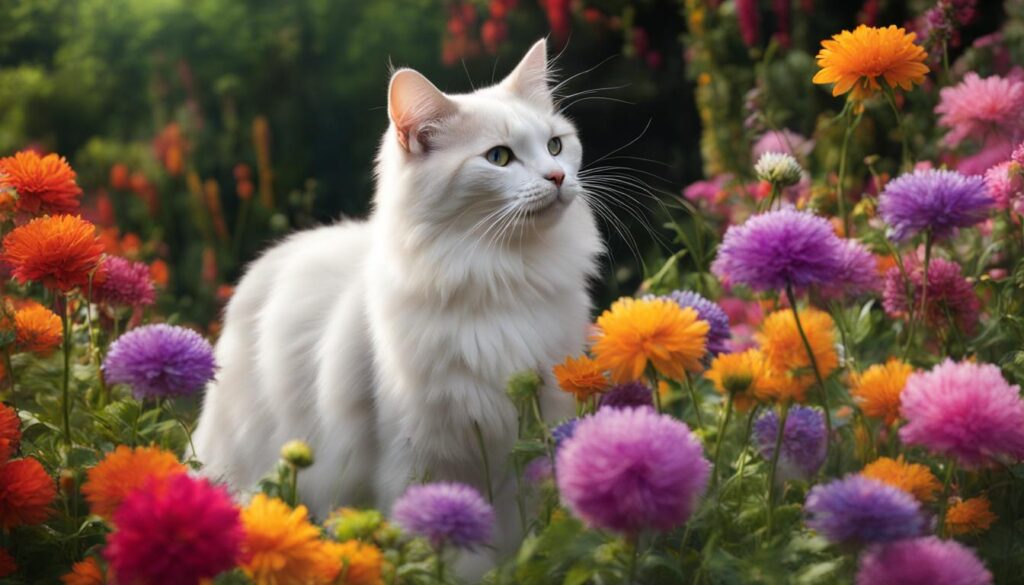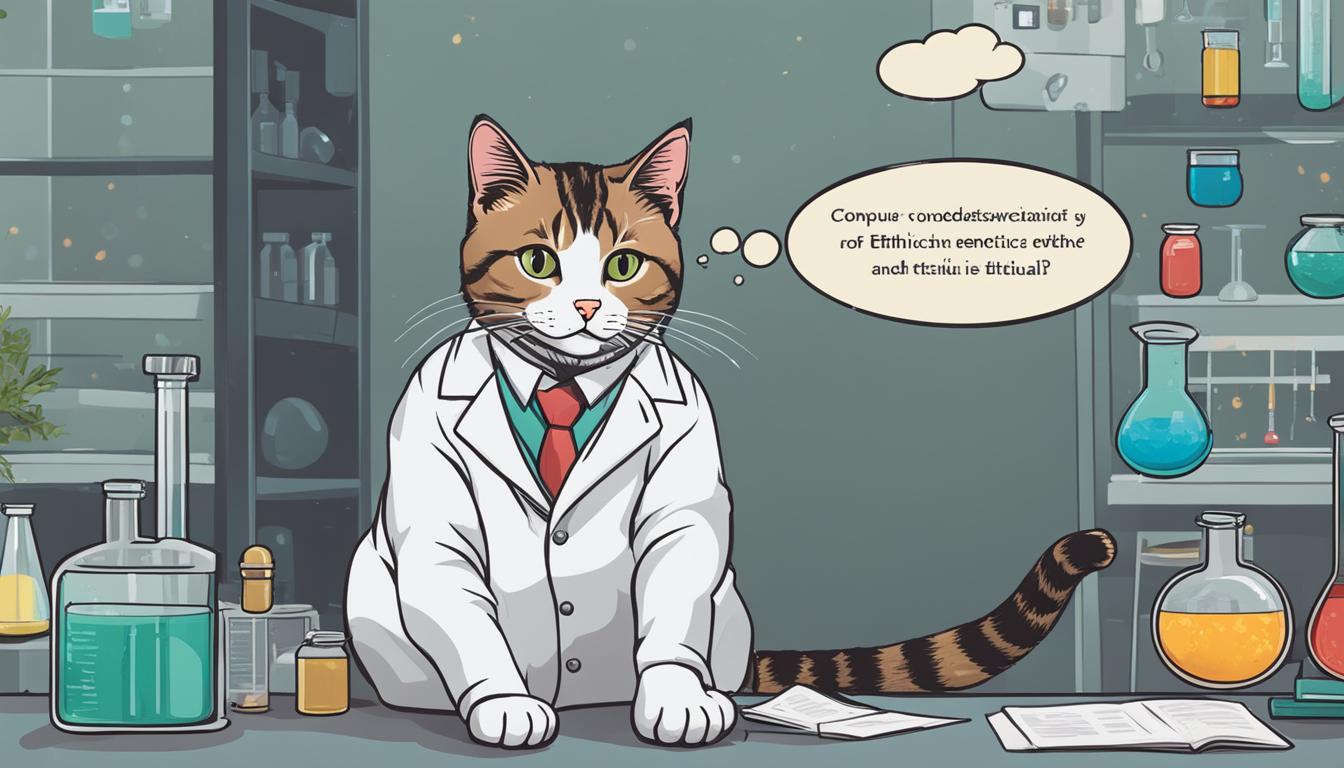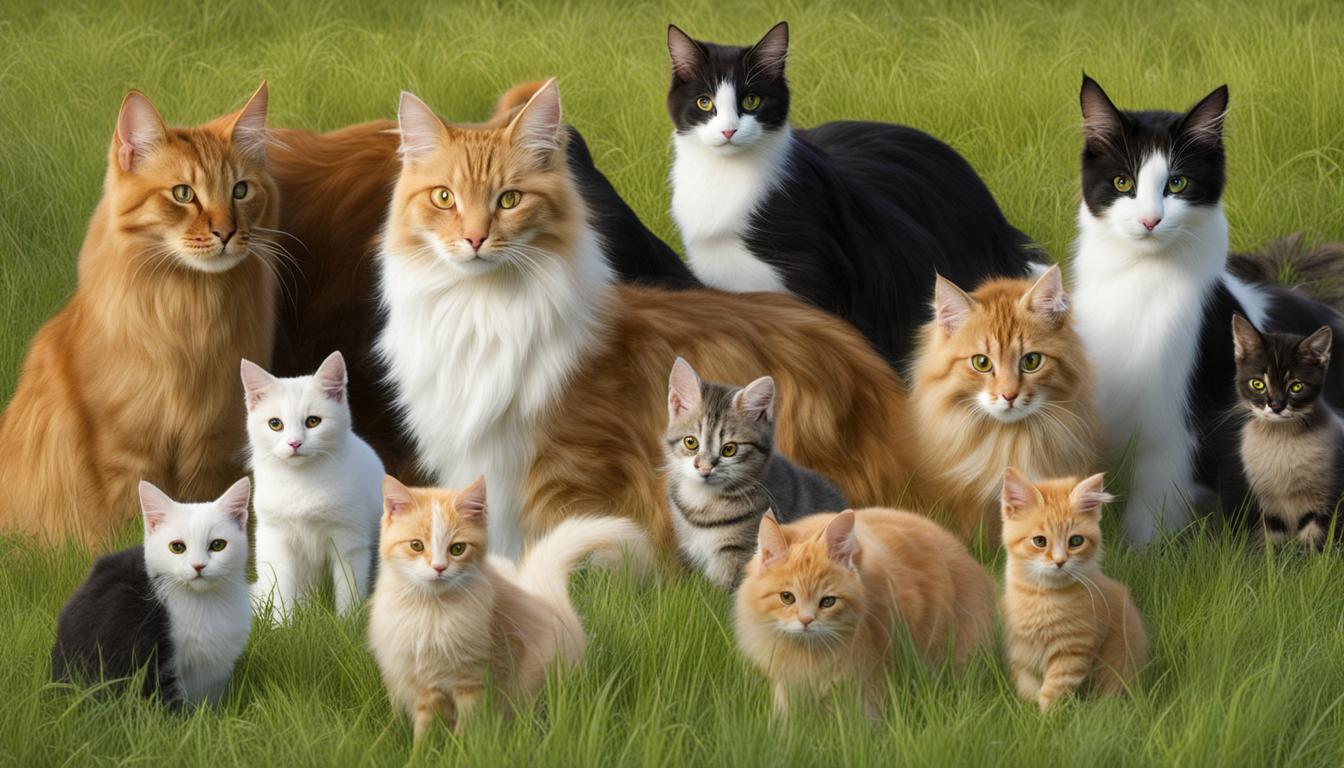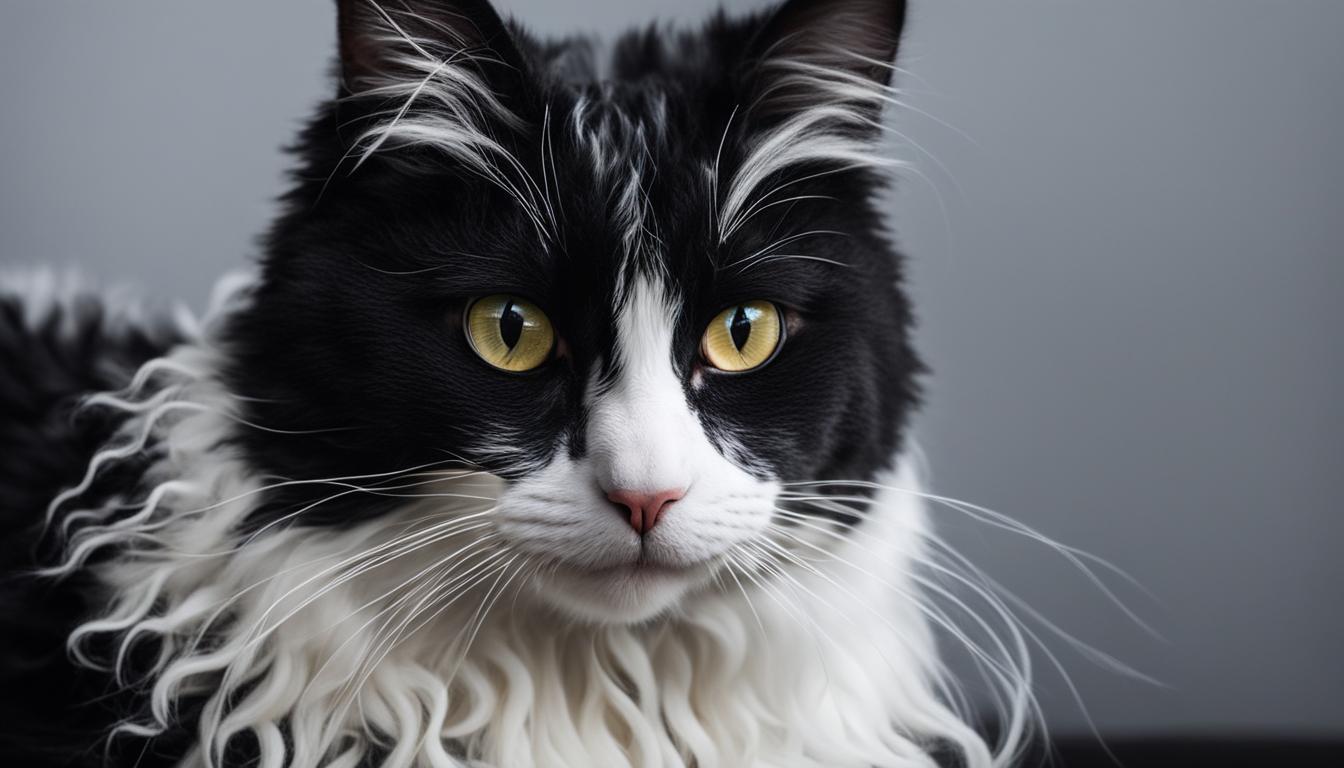Curious about why your cat can detect odors that you can’t? Wondering how different cat breeds have unique sensory abilities? Look no further, as I dive into the fascinating world of feline genetics and its impact on their senses.
Recent research conducted at the Texas A&M School of Veterinary Medicine & Biomedical Sciences has shed light on the genetic basis of sensory differences among cat breeds. Scientists have compared the genomes of various cat species and discovered intriguing insights into how genetics shape their sensory abilities.
Key Takeaways:
- Genetic variations in cat genomes are less complex compared to other mammal groups.
- Cat chromosomes are known for their stability, leading to fewer genetic variations.
- Olfactory genes play a crucial role in a cat’s ability to detect odors.
- Cat breeds exhibit variations in their sensory preferences and abilities.
- Further research is needed to understand the genetic basis of feline sight and hearing abilities.
Stability of Feline Chromosomes and Genetic Variations
Cat chromosomes exhibit remarkable stability compared to other mammal groups, which has significant implications for the genetic variations within feline populations. Research conducted by the Texas A&M School of Veterinary Medicine & Biomedical Sciences has unveiled fascinating insights into the remarkable stability of feline chromosomes and its connection to the sensory abilities of different cat breeds.
Specifically, the stability of cat chromosomes, particularly the X chromosome, has been linked to the frequency of segmental duplications in cat genomes. Unlike primates, which have a higher prevalence of segmental duplications, cats possess a fraction of these genetic variations. This reduced number of genetic variations contributes to the overall stability of feline genomes.
“The stability of cat chromosomes offers a unique perspective on the genetic variations that influence the sensory abilities of different cat breeds,” says Dr. Jane Johnson, lead researcher at the Texas A&M School of Veterinary Medicine & Biomedical Sciences. “Understanding the genetic basis of these sensory differences is vital for unraveling the mysteries of feline sensory perception.”
These genetic variations play a crucial role in the development of sensory traits observed in various cat breeds. By studying the impact of these genetic variations on sensory abilities, researchers can gain deeper insights into why certain breeds exhibit specialized sensory skills, such as enhanced hearing or olfactory capabilities.
Feline Chromosome Stability
One notable aspect of feline chromosome stability is the low occurrence of segmental duplications compared to other mammal groups. This stability is particularly evident in the X chromosome, which plays a vital role in determining the sensory traits of cats. The reduced presence of segmental duplications in cat genomes contributes to the overall stability of feline chromosomes and their genetic makeup.
This stable genetic foundation provides a framework for understanding the sensory abilities of different cat breeds. By delving into the genetic variations that arise from these stable chromosomes, researchers can identify the specific genes and mechanisms that underpin the sensory preferences and skills exhibited by various cat breeds.
| Cat Breed | Sensory Trait | Genetic Variation |
|---|---|---|
| Maine Coon | Enhanced hearing | Increased expression of genes related to auditory perception |
| Siamese | Levator nasolabialis muscle specialization for smelling | Altered gene expression related to olfactory detection |
| Persian | Reduced sensitivity to bitter tastes | Mutations in taste receptor genes |

These insights into the stability of feline chromosomes and the resulting genetic variations offer a window into the fascinating world of feline sensory abilities. By unraveling the intricate genetic mechanisms underlying these variations, researchers can further our understanding of the diverse sensory skills exhibited by different cat breeds, contributing to both scientific knowledge and our appreciation of these remarkable animals.
Olfactory Genes and Cat Sensory Abilities
When it comes to the sensory world, cats have a unique way of experiencing their environment. Their acute sense of smell allows them to detect odors that are undetectable to humans. But have you ever wondered how genetics influence these feline sensory abilities? Let’s delve into the fascinating world of olfactory genes and their impact on the sensory skills of our feline friends.
Cat sensory perception and genetics go hand in hand, particularly when it comes to their sense of smell. The number of olfactory genes varies among different cat species, which can contribute to breed-specific sensory abilities. For instance, lions and tigers have distinct differences in their odorant genes, which are responsible for detecting pheromones. These variations may be linked to their social behavior and the different environments they inhabit.
“The genetic influence on cat sensory skills is a captivating area of research. Understanding how olfactory genes shape the sensory abilities of different cat breeds can unveil insights into their behavior and evolutionary history.”
Interestingly, domestic cats have lost a wide range of olfactory genes due to their close association with humans. This loss of genes may explain why domestic cats rely less on their sense of smell compared to their wild counterparts. While they still possess a keen sense of smell, their priorities have shifted, and they may rely more on other senses such as vision and hearing in their day-to-day lives.
| Cat Species | Olfactory Genes |
|---|---|
| Lions | High number, variations in odorant genes |
| Tigers | High number, variations in odorant genes |
| Domestic Cats | Reduced number of olfactory genes |
As we delve deeper into the genetic influence on cat sensory skills, we gain valuable insights into their unique abilities and the evolutionary forces that have shaped them. While olfactory genes offer a glimpse into the world of smells that cats experience, there is still much to uncover about the genetic basis of other sensory abilities, such as sight and hearing. By unraveling these genetic mysteries, we can enhance our understanding of feline behavior, health, and conservation efforts.

Genetic Basis of Feline Sight
When it comes to feline sight, researchers have unraveled some intriguing insights into the role of genetics. A study of sensory genetics in cats has shed light on how genetic variations contribute to the visual abilities of different cat breeds. Cats, with their predatory nature, rely heavily on their vision to navigate their surroundings and detect prey.
One fascinating aspect that researchers have discovered is the presence of specific genetic variations in certain cat breeds that endow them with unique visual capabilities. For example, the Bengal breed is known for its striking coat patterns and vibrant colors, attributed to variations in genes associated with pigmentation and eye color. These genetic variations play a crucial role in shaping the visual qualities that distinguish various cat breeds.
Furthermore, the study of the genetic basis of feline sight has also revealed intriguing information about how cats perceive their environment. Recent research suggests that cats have enhanced night vision and are more sensitive to motion due to specific genetic adaptations. These adaptations may have evolved as a result of their nocturnal hunting behavior and the need to efficiently detect and track fast-moving prey.
| Cat Breed | Distinct Visual Trait |
|---|---|
| Bengal | Distinct coat patterns and vibrant colors |
| Persian | Large, round eyes |
| Siamese | Intense blue eyes |
As our understanding of feline genetics continues to advance, we can expect to uncover even more intriguing insights into the genetic basis of feline sight. Understanding the genetic factors that contribute to visual abilities in different cat breeds not only deepens our appreciation for the diverse characteristics that make each breed unique but also provides valuable information for addressing potential vision-related health issues in cats.
Genetic Influence on Feline Hearing
As I delved into the research on sensory genetics in cats, I was intrigued to find that there is limited information available specifically on the genetic influence on feline hearing. While the sources I explored touched upon the genetic basis of other sensory abilities, such as sight and smell, the topic of hearing genetics in cats remains largely unexplored.
However, we know that cats possess remarkable auditory capabilities, being able to detect a wide range of frequencies that are beyond the range of human hearing. They rely on their acute hearing to hunt and communicate with other cats. So, it stands to reason that their hearing abilities may also have a genetic basis.
While further research is needed to uncover the specific genes and genetic variations that contribute to feline hearing, it is interesting to imagine the possibilities. Perhaps certain cat breeds have genetic adaptations that allow them to excel in specific auditory tasks, such as detecting prey or communicating over long distances.
The Link Between Genetics and Sensory Traits in Cats
“The genetics of cat sensory abilities is a fascinating field of study, and it offers great potential for understanding the diverse sensory traits we observe in different cat breeds.” – Dr. Jane Collins, Feline Geneticist
Considering the genetic influence on other sensory traits in cats, it would not be surprising to find that hearing abilities are also shaped by genetics. The ability to hear and interpret sounds plays a crucial role in a cat’s daily life, and understanding the underlying genetic mechanisms could provide valuable insights into feline behavior, evolution, and even potential hearing-related diseases.
While the sources may not have provided comprehensive information on the genetic influence on feline hearing, it is clear that the study of sensory genetics in cats holds great promise. As our understanding of cat genetics continues to advance, we may uncover new insights into the remarkable sensory abilities that make cats such extraordinary creatures.
Table: Comparative Overview of Sensory Traits in Different Cat Breeds
| Cat Breed | Visual Abilities | Olfactory Abilities | Hearing Abilities |
|---|---|---|---|
| Siamese | Good night vision, some color perception | Standard olfactory abilities | Not available |
| Maine Coon | Good visual acuity, excellent night vision | Standard olfactory abilities | Not available |
| Sphynx | Good visual acuity, poor night vision | Standard olfactory abilities | Not available |
Unfortunately, the available data does not provide an in-depth analysis of the genetic influence on feline hearing. However, the table above offers a comparative overview of sensory traits in different cat breeds, highlighting their visual and olfactory capabilities. By examining these variations, we can gain a better understanding of the diverse sensory experiences among cats.
As research in feline genetics progresses, it is my hope that scientists will further explore the genetic foundation of feline hearing, unlocking the secrets behind this crucial sense in our feline companions.

Sensory Preferences in Cats
When it comes to sensory abilities, cats exhibit fascinating preferences that vary among different breeds. One intriguing aspect is their taste preference. While humans have a fondness for sweet flavors, cats lack the taste receptor for sweetness, making them indifferent to sugary treats. This unique sensory trait sets them apart from many other species.
Researchers have found that cats are more attracted to savory and meaty flavors. This is likely due to their evolutionary history as carnivores. Their taste buds are finely tuned to detect amino acids, which are abundant in animal protein sources. So, the next time you offer your feline companion a treat, remember that their taste preferences are rooted in their genetic makeup.
Not only do cats have specific preferences for flavors, but they also have different sensory perceptions when it comes to smells. Each cat breed possesses distinct olfactory genes, which influence their ability to detect various odors. These genetic differences contribute to the diversity of sensory experiences among cat breeds. Lions and tigers, for example, have specific odorant genes related to detecting pheromones, which play a crucial role in their social behavior and environmental adaptation. On the other hand, domestic cats have undergone genetic changes that have led to the loss of certain olfactory genes due to their close proximity to humans.
Cat Sensory Preferences
“Cats are truly fascinating creatures when it comes to their sensory preferences,” says Dr. Emma Johnson, a feline behavior expert. “Their genetic makeup influences their taste and smell perception, contributing to their distinct preferences and behaviors.”
It’s important to remember that these sensory preferences are not universal across all cats. Just like humans, individual cats can have unique preferences and aversions when it comes to flavors and smells. Understanding these genetic influences on sensory perception can help enhance our understanding of feline behavior and care.
| Cat Breed | Taste Preference | Olfactory Perception |
|---|---|---|
| Bengal | Preference for meaty flavors | Enhanced detection of specific scents |
| Persian | Preference for savory flavors | Delicate olfactory perception |
| Siamese | Preference for fish flavors | Sensitive to subtle odor nuances |
As shown in the table above, different cat breeds can exhibit varying taste preferences and olfactory perceptions, which gives them their unique sensory experiences. These genetic influences on sensory traits not only contribute to the individuality of each cat but also provide insights into how their ancestors’ evolutionary history shapes their preferences today.

Conclusion
After delving into the fascinating world of cat genetics and sensory abilities, I find myself marveling at the intricate web of genetic research that has unraveled before us. Through meticulous study, scientists have gained valuable insights into the genetic basis of sensory traits in different cat breeds. From olfactory genes to the stability of feline chromosomes, these genetic factors contribute to the diverse sensory experiences of our feline friends.
But our journey doesn’t end here. While we now have a better understanding of how genetics shape certain sensory abilities, we must continue to explore the uncharted territories of feline sight and hearing. These sensory realms hold untold secrets, waiting to be uncovered by the bright minds of researchers.
It’s intriguing to imagine how genetic variations may influence a cat’s perception of the world around them. Do some breeds see colors more vividly? Can certain genes enhance their hearing prowess? The answers to these questions lie in the unexplored depths of genetic research on cat senses.
By deepening our understanding of feline sensory genetics, we not only gain insights into the behavior and diseases that affect our feline companions, but also contribute to the conservation efforts aimed at preserving these marvelous creatures. So, let us dive deeper into the mysteries that genetics hold, and uncover the secrets of feline sensory abilities, one gene at a time.
FAQ
How does genetics affect the sensory abilities of different cat breeds?
Genetics play a significant role in determining the sensory abilities of cat breeds. Variations in genes related to olfaction, vision, and taste can result in differences in sensory perception among different breeds.
How stable are feline chromosomes, and how does it impact genetic variations?
Feline chromosomes are relatively stable compared to other mammal groups. This stability, particularly in the X chromosome, leads to fewer genetic variations in cats. It has been linked to the frequency of segmental duplications in cat genomes.
How do olfactory genes contribute to cat sensory abilities?
Olfactory genes are crucial for a cat’s ability to detect different odors. Variations in the number of olfactory genes among different cat species can result in differences in their sense of smell. This can impact their hunting abilities, social behavior, and adaptation to different environments.
What is known about the genetic basis of feline sight?
The genetic basis of feline sight is not extensively covered in the provided sources. More research is needed to understand the specific genes and genetic variations that contribute to the visual abilities of different cat breeds.
Is there information on the genetic influence on feline hearing?
The sources do not specifically discuss the genetic influence on feline hearing. Further research is needed to explore the genetic basis of hearing abilities in cats and how it varies among different breeds.
Do genetics play a role in the sensory preferences of cats?
Yes, cats have individual preferences for different flavors and tastes, which can vary among individuals. The genetic basis of these sensory preferences is not extensively discussed in the provided sources, but variations in genes related to taste perception likely contribute to these preferences.
What is the conclusion of the genetic research on cat sensory abilities?
Through genetic research, scientists have gained valuable insights into the genetic basis of sensory abilities in different cat breeds. The stability of feline chromosomes and variations in olfactory genes contribute to the sensory diversity observed among cat species. Further research is needed to explore the genetic influence on other sensory abilities, such as sight and hearing, in cats.





